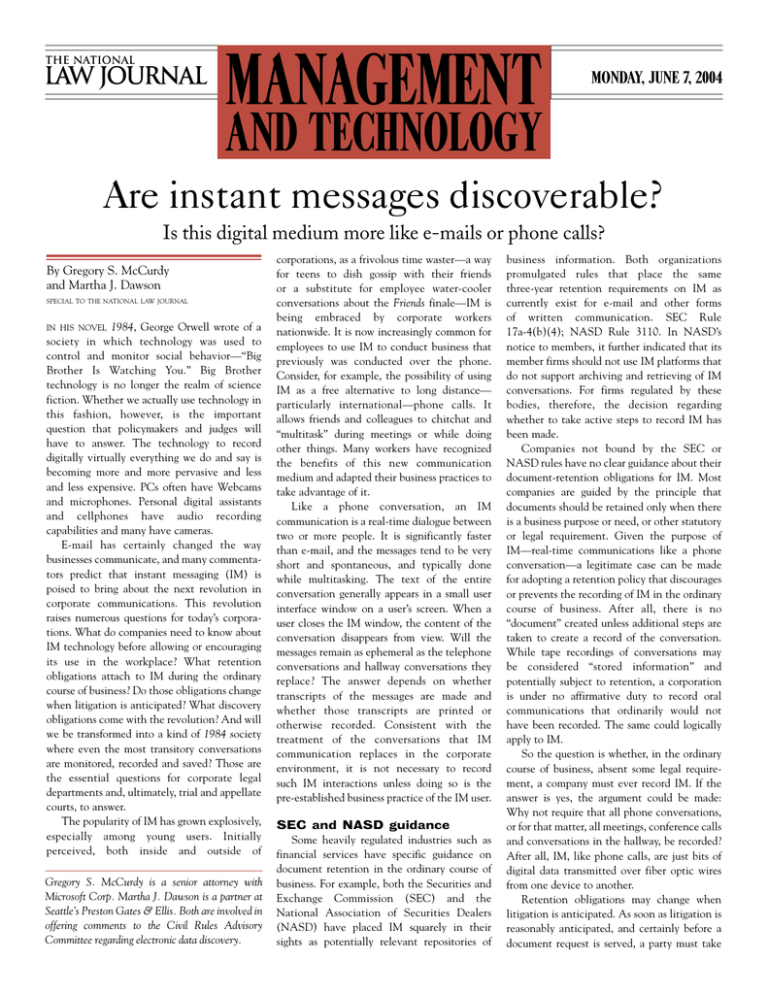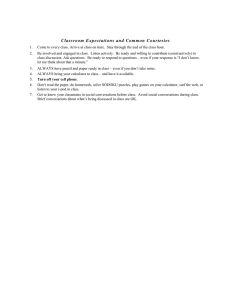
MANAGEMENT
MONDAY, JUNE 7, 2004
AND TECHNOLOGY
Are instant messages discoverable?
Is this digital medium more like e-mails or phone calls?
By Gregory S. McCurdy
and Martha J. Dawson
SPECIAL TO THE NATIONAL LAW JOURNAL
1984, George Orwell wrote of a
society in which technology was used to
control and monitor social behavior—“Big
Brother Is Watching You.” Big Brother
technology is no longer the realm of science
fiction. Whether we actually use technology in
this fashion, however, is the important
question that policymakers and judges will
have to answer. The technology to record
digitally virtually everything we do and say is
becoming more and more pervasive and less
and less expensive. PCs often have Webcams
and microphones. Personal digital assistants
and cellphones have audio recording
capabilities and many have cameras.
E-mail has certainly changed the way
businesses communicate, and many commentators predict that instant messaging (IM) is
poised to bring about the next revolution in
corporate communications. This revolution
raises numerous questions for today’s corporations. What do companies need to know about
IM technology before allowing or encouraging
its use in the workplace? What retention
obligations attach to IM during the ordinary
course of business? Do those obligations change
when litigation is anticipated? What discovery
obligations come with the revolution? And will
we be transformed into a kind of 1984 society
where even the most transitory conversations
are monitored, recorded and saved? Those are
the essential questions for corporate legal
departments and, ultimately, trial and appellate
courts, to answer.
The popularity of IM has grown explosively,
especially among young users. Initially
perceived, both inside and outside of
IN HIS NOVEL
Gregory S. McCurdy is a senior attorney with
Microsoft Corp. Martha J. Dawson is a partner at
Seattle’s Preston Gates & Ellis. Both are involved in
offering comments to the Civil Rules Advisory
Committee regarding electronic data discovery.
corporations, as a frivolous time waster—a way
for teens to dish gossip with their friends
or a substitute for employee water-cooler
conversations about the Friends finale—IM is
being embraced by corporate workers
nationwide. It is now increasingly common for
employees to use IM to conduct business that
previously was conducted over the phone.
Consider, for example, the possibility of using
IM as a free alternative to long distance—
particularly international—phone calls. It
allows friends and colleagues to chitchat and
“multitask” during meetings or while doing
other things. Many workers have recognized
the benefits of this new communication
medium and adapted their business practices to
take advantage of it.
Like a phone conversation, an IM
communication is a real-time dialogue between
two or more people. It is significantly faster
than e-mail, and the messages tend to be very
short and spontaneous, and typically done
while multitasking. The text of the entire
conversation generally appears in a small user
interface window on a user’s screen. When a
user closes the IM window, the content of the
conversation disappears from view. Will the
messages remain as ephemeral as the telephone
conversations and hallway conversations they
replace? The answer depends on whether
transcripts of the messages are made and
whether those transcripts are printed or
otherwise recorded. Consistent with the
treatment of the conversations that IM
communication replaces in the corporate
environment, it is not necessary to record
such IM interactions unless doing so is the
pre-established business practice of the IM user.
SEC and NASD guidance
Some heavily regulated industries such as
financial services have specific guidance on
document retention in the ordinary course of
business. For example, both the Securities and
Exchange Commission (SEC) and the
National Association of Securities Dealers
(NASD) have placed IM squarely in their
sights as potentially relevant repositories of
business information. Both organizations
promulgated rules that place the same
three-year retention requirements on IM as
currently exist for e-mail and other forms
of written communication. SEC Rule
17a-4(b)(4); NASD Rule 3110. In NASD’s
notice to members, it further indicated that its
member firms should not use IM platforms that
do not support archiving and retrieving of IM
conversations. For firms regulated by these
bodies, therefore, the decision regarding
whether to take active steps to record IM has
been made.
Companies not bound by the SEC or
NASD rules have no clear guidance about their
document-retention obligations for IM. Most
companies are guided by the principle that
documents should be retained only when there
is a business purpose or need, or other statutory
or legal requirement. Given the purpose of
IM—real-time communications like a phone
conversation—a legitimate case can be made
for adopting a retention policy that discourages
or prevents the recording of IM in the ordinary
course of business. After all, there is no
“document” created unless additional steps are
taken to create a record of the conversation.
While tape recordings of conversations may
be considered “stored information” and
potentially subject to retention, a corporation
is under no affirmative duty to record oral
communications that ordinarily would not
have been recorded. The same could logically
apply to IM.
So the question is whether, in the ordinary
course of business, absent some legal requirement, a company must ever record IM. If the
answer is yes, the argument could be made:
Why not require that all phone conversations,
or for that matter, all meetings, conference calls
and conversations in the hallway, be recorded?
After all, IM, like phone calls, are just bits of
digital data transmitted over fiber optic wires
from one device to another.
Retention obligations may change when
litigation is anticipated. As soon as litigation is
reasonably anticipated, and certainly before a
document request is served, a party must take
THE NATIONAL LAW JOURNAL
reasonable steps to preserve evidence over
which it has control and that is reasonably
likely to be material to the potential action and
the subject of a discovery request. See, e.g.,
Wigington v. CB Richard Ellis, 2003 WL
22439865 (N.D. Ill. Oct. 27, 2003).
Such evidence is usually embodied
in what most people think of as “documents.”
The very nature of electronically stored
information, however, has changed and will
continue to change notions of what comprises
a document. Two questions arise at this point:
Are IM conversations that were archived in
the ordinary course of business “documents”
subject to discovery? Do retention obligationsregarding IM change once litigation is anticipated?
Federal Rule of Civil Procedure 34 provides
for requests for “documents,” including
“electronic data compilations.” Today,
electronically stored information, such as
e-mail, is included in the definition of a
“document” because that is how lawyers and
judges are used to thinking of fact discovery. In
reality, the term document is an inherently
arbitrary concept when applied to electronically stored information. A letter written in
Microsoft Word, for example, is really just
information that can be understood by
Microsoft Word software, which then displays
some of the information on a screen or prints it
into what we commonly think of as a paper
document. Other parts of the data file are not
displayed and can only be accessed by viewing
the metadata or embedded data. The computer
file, however, is itself simply information:
information about the text of the letter, the
font of the print, the margins of the page and
even “embedded” information about changes
made to the letter, editors who worked on the
letter and so on.
The fact that all of this information is
contained in one “file” the name of which
ends in “.doc,” however, is purely a design
decision by Microsoft engineers. The information could just as easily be divided into
multiple files that are simply associated with
each other. For example, the text information
could be in one “.doc” file, the formatting
information in an “.fmt” file and the editing
information in an “.edt” file. Which file is
then the document?
A change to the federal rules that
incorporates “electronically stored information” into the Fed. R. Civ. P. 34 definition of
the term “document” will arguably stand the
test of time better than a definition dependent
MONDAY, JUNE 7, 2004
upon current notions of what we think of as
documents. Such an addition to the federal
rules has recently been proposed by the
Advisory Committee on Federal Rules of Civil
Procedure to the Standing Committee on
Rules of Practice and Procedure. Ultimately, it
is information that is stored in whatever media
happen to be in use at the time, which is
discoverable in litigation.
Whether IMs are “electronically stored information,” and therefore documents potentially
discoverable when litigation is filed, depends on
numerous factors: the IM software program in
use; its default settings; the options that have
been activated by the users and/or by their
corporate information systems personnel in
deploying that system; and, in some instances,
whether the individuals have taken steps to
record the particular conversation (for example,
by checking a dialogue box or by cutting and
pasting the text into a file and saving it there).
If Fed. R. Civ. P. 34 is amended to
include “electronically stored information,” the
conclusion that stored IM conversations are
discoverable is unavoidable. The question,
however, is: When does an IM conversation
change from being an ephemeral exchange
of information to one that is “stored” and
therefore subject to the same requirements as
other electronically stored information?
Although many IM platforms initially did
not permit the user to record a conversation,
many software developers have incorporated
archive and retrieval capabilities into their IM
software. Arguably, as such capabilities are
recognized by IM users, more of them will begin
to record and refer back to IM communications
in much the same way that they currently do
to e-mail. It is only a matter of time before
attorneys routinely include a request for IM
conversations on topics relevant to litigation
in their discovery requests. There can be
little debate, therefore, that IM conversations,
if recorded, are discoverable in litigation and
must be preserved if one has reason to
anticipate relevant litigation.
An obligation to record?
The question of whether an obligation to
start recording potentially relevant IM arises
once litigation is anticipated is far less clear.
While it is true that with many IM services it is
fairly easy to record a conversation as a text file,
instituting a requirement to record IM conversations could be considered akin to requiring all
corporate employees to begin recording routine
telephone conversations or meetings that might
arguably bear on the case in question merely
because that is technically possible though not
done in the ordinary course. This is clearly not
the law and never has been.
The key is that information that comes into
a tangible existence, i.e., is “stored” in some
capacity in the ordinary course of business,
is subject to discovery. But does the mere
ability to store that information justify a new
obligation of a party to a case to create and
maintain wholly new “documents” solely for
the purpose of discovery in the litigation?
Although a litigant may be required to
compile existing data, it generally may not be
compelled to create information that is not and
has never been in existence. Thus, while tape
recordings of conversations may be considered
“stored information” subject to preservation if
litigation is anticipated, a party is under no
affirmative duty to record oral communications
that have not otherwise been recorded in the
ordinary course of business. The same would
seem logically to apply to IM conversations not
recorded by the participants in the conduct of
their daily business.
As the very name implies, all software
products are inherently flexible and easy to
redesign to serve new purposes and be more
effective. Just as car companies produce
new models every year with updated styles,
designs and technology, software companies
update and improve their products on a regular
basis in order to meet consumer demand
and keep up with competitors. Undoubtedly
as technology advances, courts and litigants
will continue to struggle with the definition
of what constitutes a “document” and what
are the document-retention obligations both
in the ordinary course of business and when
litigation is anticipated. Just because technology permits us to record and preserve for
eternity every spoken or written word does not
necessarily mean that Big Brother surveillance
is good or needed for business or as a matter
of law and policy. NLJ
www.prestongates.com
This article is reprinted with permission from the June 7, 2004 edition of THE NATIONAL LAW JOURNAL. © 2004 ALM Properties, Inc. All rights reserved. Further
duplication without permission is prohibited. For information, contact American Lawyer Media, Reprint Department at 800-888-8300 x6111. #00-06-04-0008



